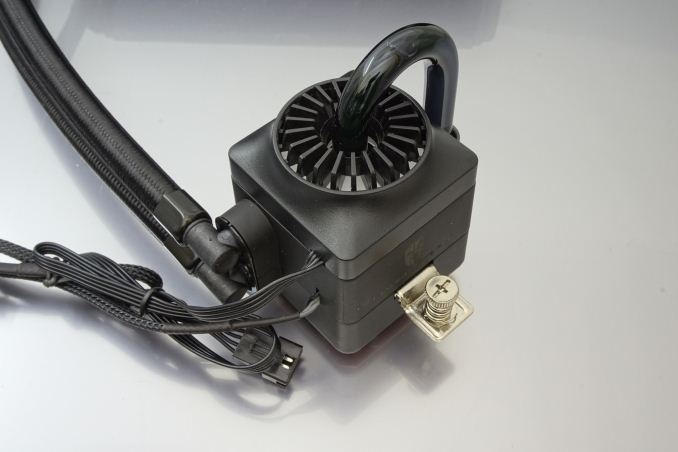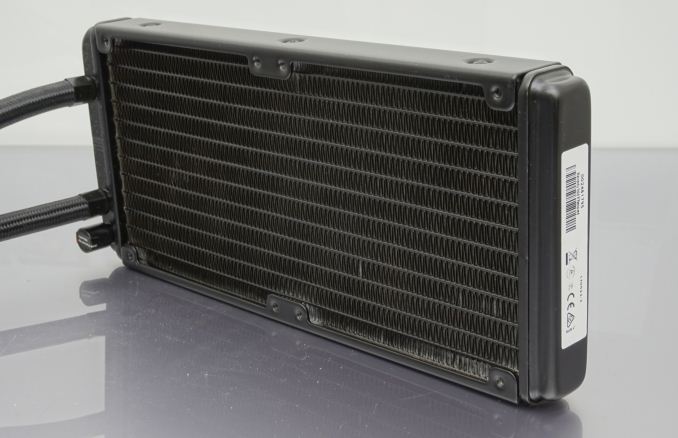The DeepCool Captain 240 EX RGB AIO Cooler Review: Pump it Up, Without the Noise
by E. Fylladitakis on December 14, 2017 9:00 AM EST- Posted in
- Cases/Cooling/PSUs
- AIO
- Deepcool
- Cooler
Conclusion
DEEPCOOL obviously wanted to keep things simple and risks low with the release of the Captain EX 240 RGB. They simply took the core design of their former all-in-one cooler, the Captain EX 240, and added RGB lighting to it. The Captain EX 240 was a commercially successful product, with good ratings and proven performance. Adding RGB lighting to it should have been a trivial matter for DEEPCOOL’s engineers and the production of the new model would not require any significant production line modifications, allowing the company to quickly market a competitively priced cooler with RGB lighting.
The stock thermal performance of the DEEPCOOL Captain EX 240 RGB is average. The Captain EX 240 RGB actually falls behind most of the similarly sized AIO coolers that we have tested to this date. DEEPCOOL’s unique fans do not seem to help with the cooler’s thermal performance either, as the thin radiator has low-to-medium airflow impedance and limited dissipation surface. Only significantly higher airflow fans would be able to make an actual difference here.
On the other hand, DEEPCOOL’s engineers designed the TF120 fans to be quiet, and quiet they are. That makes the Captain EX 240 RGB one of the quietest dual-fan AIO coolers in our database. Many competitive products that offer better thermal performance than the Captain EX 240 RGB also are much louder. The only (similarly sized) direct competitors of the Captain EX 240 RGB in terms of silent operation are the Fractal Design Celsius S24 and the Alphacool Eisbaer 240, which lack RGB lighting and/or retail at a significantly higher price.
The highlight of the DEEPCOOL Captain EX 240 RGB is neither its thermal performance or the quiet operation, but its design. The Captain EX 240 RGB implements the same “external circulation” design that made its predecessor famous, which is a nothing more than a short glass tube attached on the CPU block assembly. It is just an aesthetic upgrade that has no practical purpose, yet it was enough to improve the popularity of the Captain EX 240. The unique feature of the Captain EX 240 RGB is the addition of RGB lighting, which may be a double-edged knife for some users. The operation of the RGB LEDs requires a controller and, if the motherboard does not have RGB strip header(s), the controller that DEEPCOOL provides is very basic and requires opening up the case every time you want to change a setting/color. Users that like very clean designs would probably prefer to purchase the Captain EX 240 over its RGB variant, sacrificing the RGB lighting for fewer cables and gizmos to hide. Finally, the rubber tubing perhaps is a bit too thick and inflexible, but it definitely is very tough, and its exterior layer has it looking much like a high-pressure braided hose.
The current retail price of the DEEPCOOL Captain EX 240 RGB is $120 including shipping, placing it dangerously close to other products that may be lacking the RGB lighting but offer better overall performance. The vanilla Captain EX 240 retails for $90 and is virtually the same cooler, minus the RGB lighting and the extra RGB strip. For people who value quiet operation over raw thermal performance and want a quality product, either version of the Captain EX 240 is a sensible choice and may even be quite the bargain during a sale. Whether the addition of RGB lighting is worth the extra $30, we leave this decision to you.












34 Comments
View All Comments
Yuriman - Thursday, December 14, 2017 - link
It would be nice to see some common heatsinks within the same price bracket included in the comparison charts, even if it's only a handful. They're direct competition after all.HollyDOL - Thursday, December 14, 2017 - link
I have to agree, otherwise the results are quite relative.Put in at least a couple for reference (like Intel highend stock, AMD highend stock, and some elite one like Noctua NH-D15), it would make the info much more worthwhile for general public
HollyDOL - Thursday, December 14, 2017 - link
not like stock coolers could hope to do anything except bbq with 340W load ofc...Dr. Swag - Thursday, December 14, 2017 - link
Awesome! A decent alternative to the S24 when it comes to quiet AIOs that also has rgb!sweetca - Thursday, December 14, 2017 - link
Catchy name.Lord of the Bored - Saturday, December 16, 2017 - link
"I am Captain DeepCool, of the Federation starship EX RGB."ReeZun - Thursday, December 14, 2017 - link
Sometimes I wonder... if some of these reviews are sponsored (either by one manufacturer or a group of manufacturers, to boost brand exposure and potentially sales)... and not necessarily direct monetary sponsorship. I also wonder... if the reason Anandtech didn't include a high-end air cooler (e.g., NH-D15)... is because it would make a strong case for the AIO solutions making a very poor value proposition... especially when considering noise/cooling ratios... and, in turn, rendering this entire review pointless.E.Fyll - Thursday, December 14, 2017 - link
Actually, the answer to your question is far less complicated than that. We only compare air coolers to air coolers and liquid coolers to liquid coolers because each represents a specific type of product. It's an "apples to apples" kind of thing. I also personally do not believe that these two actually compete with each other. Users are much more likely to go for an AIO cooler because they want easier access to their system, or because they just don't like a 2kg piece of metal hanging off their motherboard, or just because it "looks cool", than for the performance. If acceptable performance is all that a user needs, an average air cooler can do the job just fine, they do not even need a NH-D15 to begin with.Besides that, the magic of having and using professional equipment like ours is that everything is both repetitive and comparable. They were all tested on the exact same device and everything is in our methodology page that can be found in every cooler review. Long story short, you can easily go to our review of the NH-D15 cooler (or any cooler that you'd like to compare, regardless of its type and platform) and just compare any of its performance figures to any AIO cooler that you want to, taking into account your personal requirements too.
tricomp - Thursday, December 14, 2017 - link
Sorry no.. it is green apples to red apples in most buyers considerations.. or dreams, and they really need to know what they are paying extra in case their dream comes true.rtfmx9 - Thursday, December 14, 2017 - link
I think that "apples to apples" does not hold here. After all, both liquid and air coolers serve the same purpose. It would be nice to be able to compare them without having to do research through Anandtech's archives. Is it possible that once comparison is made obvious liquid coolers don't make sense from the cost/performance point of view? I don't know since review does not try to inform me from that perspective. My guess is that there are many people who would like to inform themselves of whether upgrade to a liquid cooler would make sense or not but to do that you recommend that they dig though the past reviews instead of you offering that information in your review. All for the sake of keeping apples and oranges separated. I don't buy that reasoning.